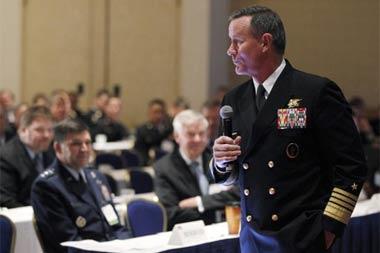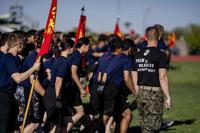TAMPA -- The wars in Iraq and Afghanistan forced the Pentagon to depend so much on special operations units to fill countless nights hunting terrorists and insurgents in direct-action missions that U.S. Special Operations Command leaders worry special operators’ non-kinetic skills have atrophied.
Adm. William McRaven, SOCOM commander, said Tuesday the special operations community is immersed in a transitional “pivot” from a decade focused largely on ground-combat counterinsurgency and counter-terrorism to a larger focus on building global partner capacity.
McRaven spoke to an audience of special operators and defense industry executives at the 2013 Special Operations Forces Industry Conference (SOFIC) here. The Navy SEAL told the crowd that he expected the number of kinetic missions to drop and an increase in demand for special operators to train foreign forces -- the mission for which Special Forces was created.
“We will always have the world’s best direct-action force,” he said. “We will increasingly be building host nation capability networked with everyone else in the SOCOM community.”
Special operators depended on these skills at the outset of the war in Afghanistan in 2001 when units entered the country and trained Afghan units fighting the Taliban. However, as the focus shifted to Iraq and the growth of insurgent forces, search and seizure missions dominated the focus of U.S. Special Operations Command.
Traditional special operations missions such as nation building and foreign forces training were often handed off to conventional forces in the counter-insurgency battles the U.S. faced in Iraq and Afghanistan.
With U.S. combat forces scheduled to leave Afghanistan next year, McRaven understands that his forces must return to their roots and pursue missions in Africa and the Pacific where foreign force training is needed to prevent terrorist organizations from gaining a foothold.
Special operations forces remain spread across the globe. A relatively slower operations tempo in Afghanistan has allowed the special operations community to consider its future missions.
McRaven signed a white paper with Army Chief of Staff Gen. Ray Odierno and Marine Corps Commandant Gen. James Amos as a part of the Strategic Landpower Task Force. In it, the leaders of the U.S. ground forces explained the importance of the “human domain” and the ability of special operations and ground forces to shape it.
This human domain is shaped by the “physical, cultural and social environments” that exist within a conflict. In the Task Force’s first policy offering released May 13, McRaven, Odierno and Amos said it will determine future wars.
McRaven made reference to last year’s SOFIC event in which former Secretary of State Hillary Clinton talked about the delicate balance between rigorous combat skill and the diplomatic finesse of relationship-building and information gathering known to characterize the unique blend of special operations talents.
“Officers and enlisted men from 96 nations in this room were here to listen to Clinton talk about how it was just as important for them to learn to drink tea -- as it is to be able to raid a compound,” McRaven said.
The SOCOM commander talked about the requisite balance of skills in the context of articulating a future vision for the force which includes the expansion of SOF global connectedness in the face of several Global Threat Networks. Along these lines, he talked about SOF units in light of the Pentagon’s Defense Strategy, which calls for an agile, deployable, ready force able to move across geographic boundaries.
























